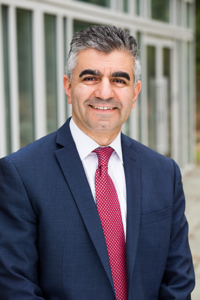AUTHENTIC CHANGE WILL REQUIRE CHANGING AN ENTIRE SYSTEM
Babson administrators, striving for transparency, admit the calls to action found in the petition are justified. But they say addressing them and making a shift is an undertaking that requires the institution to come together on a broad, systemic level — often not easy to do in higher education.
“I think collectively, in higher education, we could be doing more honestly,” says Amir Reza, Babson’s vice provost for international & multicultural education. “This is a work in progress where we’re just making a little bit of inroads. If you want to think very critically about systemic issues of access and equality that still exist in higher ed and business schools, we can have more strategic ways of attracting underrepresented students. Especially when you look at graduate business schools, the pipelines are still very homogenous and predominantly white. Having more faculty of color — which has great dividends for our students — has still been a struggle. We still have a long way to go.”
As far as the Babson curriculum goes, “That’s a tough nut to crack,” Reza says. “We work hand-in-hand with faculty, we try to compliment what the curriculum offers, but there are still ways you can systematically interject issues around diversity and inclusion into all aspects of it. However, it requires significant development from faculty and the people who are designing the curriculum and that needs to come from all angles: the faculty themselves, provosts, deans, etc. A lot of these professors are experts in their own areas and not really jumping at the chance to introduce new material. These are systemic issues that continue to plague our efforts to be that ultimate inclusive campus we would like to be.”
Jamie Kendrioski, Babson’s director of international services & multicultural education, echoes Reza’s sentiments.
“It can’t just be solely up to the multicultural office or the person in charge of diversity,” Kendrioski says. “If schools are not infusing and embedding it into the curriculum and co-curriculum, you’re not going to have the climate that’s valuable and affirming. We do a pretty good job of encouraging colleagues to take this on and not to just accept this as the problem of just one office. Then there are things to think about such as faculty and staff evaluations. Are we rewarding people who are committed to taking on new initiatives when you’re talking about things like promotions and tenure?”
‘I WANTED TO CHANGE THE SYSTEM, BUT I ALSO NEEDED TO FOCUS ON MY GRADES’
It also cannot continue to fall on the shoulders of students who, more often than not, are leading the charge, Babson officials tell Poets&Quants.
“A lot of initiatives are very student-led,” Anderson says. “We put work on students to do the job of changing a system we continue to perpetuate. We ask them to tell us their experience, but I don’t know that we do a good enough job to listen. Then, we walk ourselves into corners where we’re unwilling or unable to change or answer.”
According to Mendes, the weight that falls on minority students is very heavy and is carried with them everyday when they don’t see themselves represented among faculty, staff, and students or when they experience micro-aggression or other uncomfortable episodes inside the classroom on account of their ethnicities.
“It can be hard being in this environment,” she says. “The things that make it hard are a few different areas. One issue I used to run into was that faculty didn’t know how to address some of these issues and didn’t know how to speak about diversity issues with people of color. I’ve literally been called out because I was the only black student in the classroom and left feeling uncomfortable because I was the only one. You also see a fearlessness of white faculty speaking about things they shouldn’t be or need to be educated about, which is where faculty training comes in.
“Another area that can be difficult is being around white students who are experiencing being around black people for the very first time in their lives. Or being in group meetings being spoken over and not listened to or a white student repeating something a black student said then all of a sudden it catapults and becomes a revolutionary idea.”
Mendes explains that these and other shared experiences among students of color on a predominantly white campus are what prompts them to be proactive. “Feeling intimidated and unwanted drives us to find cohorts of friends to speak about it with and to create initiatives and events meant to drive change,” she says. “I wanted to change the system, but I also needed to focus on my grades.”
Although it’s mostly the students of color who feel and carry the weight, Mendes says there are white students who do attend events and who speak up about the issues.
Anderson says she sees it as well. “I think there are majority students also saying this isn’t okay, that the institution isn’t doing enough,” says Anderson. “We sometimes hear students in the majority say, ‘I don’t think I’m equipped to navigate this world if I only have people around me who look like me or issues that are only related to me.’”











